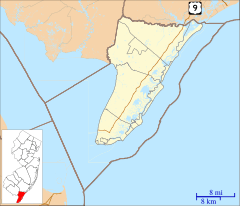Stone Harbor Bird Sanctuary facts for kids
Quick facts for kids Stone Harbor Bird Sanctuary |
|
|---|---|
 |
|
| Location | Cape May County, New Jersey |
| Nearest city | Stone Harbor |
| Area | 21.5 acres (8.7 ha) |
| Established | 1947 |
| Designated: | 1965 |
The Stone Harbor Bird Sanctuary is a special place for birds and nature in Stone Harbor, Cape May County, New Jersey. It covers about 21.5 acres (8.7 hectares) of land. This sanctuary was created in 1947 by the local town. It became even more important in 1965 when it was named a National Natural Landmark. This was the very first place in New Jersey to get this special title!
Contents
History of the Sanctuary
Birds like herons started building their nests in this area around 1938. The town decided to protect this important spot in 1947. To keep the birds safe, a fence was put up around the sanctuary in 1961.
By 1964, more than 5,000 birds would come to the sanctuary each year. They arrived for nesting season from March through July. These birds would often stay until December before leaving.
Changes and Restoration Efforts
Around 1995, something changed. The number of nesting shore birds, like herons, coming back to the sanctuary started to drop. By the year 2000, almost no herons were nesting there anymore.
To help the birds return, the sanctuary began a big project in 2005. They wanted to make the area better for nesting birds. Part of this plan was to let more tidal water flow into the site. They also worked to remove plants that didn't belong there. New nature trails were also added for visitors to enjoy.
Plants and Animals
The Stone Harbor Bird Sanctuary has many different types of plants. It is covered with thick bushes and shrubs. These plants offer great places for birds to hide and rest. The sanctuary also has a fresh water pond and a fresh water meadow. There is even a maritime forest, which is a type of forest found near the sea.
Right next to the sanctuary is Nummy Island. This island is a salt marsh. Salt marshes are important because they provide food and nesting spots for many birds.
Birds of the Sanctuary
Before 1995, many kinds of birds were seen at the sanctuary. These included beautiful snowy egrets and glossy ibis. You could also spot different types of herons like black-crowned and yellow-crowned night herons. Other herons seen were little blue herons, green herons, and tri-colored herons.
After the nesting birds disappeared, new bird surveys were done. In 2003, experts from The Wetlands Institute found different birds. They saw American redstarts, black and white warblers, and black-throated blue warblers. Downy woodpeckers and sharp-shinned hawks were also identified. Sadly, the egrets and herons that used to be common were not found.
Protecting Wildlife
In 2005, a problem with feral cats was addressed. These are cats that live in the wild and can harm birds. Several feral cats were safely removed from the sanctuary. Now, there are rules in place. People can get fines if they feed stray cats without a special license. This helps keep the birds and other wildlife safe.


